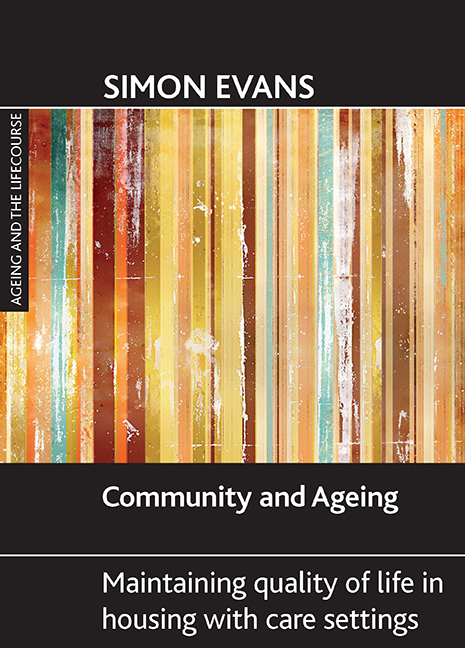Book contents
- Frontmatter
- Contents
- List of tables, boxes and photos
- Acknowledgements
- Foreword
- one Introduction
- two What is community?
- three Community and ageing
- four Housing with care communities in the UK
- five An international perspective on retirement villages
- six Promoting a sense of community in housing with care settings
- seven Diversity, community and social interaction
- eight Changing communities and older people
- nine Conclusion
- Appendix
- References
- Index
seven - Diversity, community and social interaction
Published online by Cambridge University Press: 05 July 2022
- Frontmatter
- Contents
- List of tables, boxes and photos
- Acknowledgements
- Foreword
- one Introduction
- two What is community?
- three Community and ageing
- four Housing with care communities in the UK
- five An international perspective on retirement villages
- six Promoting a sense of community in housing with care settings
- seven Diversity, community and social interaction
- eight Changing communities and older people
- nine Conclusion
- Appendix
- References
- Index
Summary
Introduction
Retirement villages are widely marketed as ‘communities’ for people from similar backgrounds who aspire to similar lifestyles. For example, Roseland Parc in Cornwall, England, tempts potential buyers with the promise that ‘The village community atmosphere will allow you to forge new friendships with like-minded people who share your interests, your joys and your challenges in life’. This emphasis on sameness is even more pronounced in the US, where retirement housing schemes are frequently based around a common interest in golf or other leisure activities. Diversity is seldom trumpeted as a selling point, although extra care housing is often more open about supporting people with a range of care needs, largely due to its roots in social care provision. At the same time there is a recognition that the overall housing sector needs to support an ageing population that is increasingly diverse in terms of age, cognitive functioning, mobility, health status, care needs, lifestyles and aspirations.
This chapter explores the extent to which diversity can be supported in housing with care settings and examines how notions of ‘like-mindedness’ sit with theories of community and government policies that promote ‘mixed communities’ (see for example ODPM, 2003b). A number of challenges to supporting diversity are identified, including a lack of clear information about the nature of such settings, tensions between residents from different socio-economic backgrounds and a lack of tolerance of different lifestyles. I also discuss the age-segregated nature of most housing and care environments and the implications of this for social cohesion and the concept of community. A range of other factors are identified as important to promoting diversity, including the siting of community facilities, the availability of inclusive activities and accessible design.
The chapter finishes with an analysis of the extent to which the relatively limited diversity found in housing with care schemes fits in with the claims made for them as communities. It also explores the nature of community in age-segregated settings and considers whether specialist housing of this type is an indication of a failure to integrate older people into society.
Diversity and community theory
Much of the body of theory on ‘community’ emphasises sameness rather than difference, focusing as it does on common interests, similar lifestyles, collective goals and shared identities.
- Type
- Chapter
- Information
- Community and AgeingMaintaining Quality of Life in Housing with Care Settings, pp. 93 - 108Publisher: Bristol University PressPrint publication year: 2009



